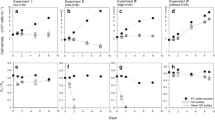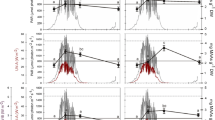Abstract
From September to November 1991, UV-absorbing mycosporine-like amino acids (MAAs) were monitored in a natural population of the sea urchin Sterechinusneumayeri from a coastal area of Anvers Island (Antarctic Peninsula). MAA concentrations were determined for specific tissues (gonad, digestive tract and body wall) from adults collected at four depths (intertidal, 8, 15 and 24 m). Four MAAs were identified: mycosporine-glycine, shinorine, porphyra-334 and paly-thine. Concentrations of MAAs among replicate individuals varied considerably. Ovaries had high concentrations of MAAs (84 to 1389 μg g−1 dry wt), while testes had non-detectable levels. The relative abundance of specific MAAs in ovaries appeared to be related to the spawning cycle. Digestive-tract samples had MAA concentrations as high as 3000 μg g−1 dry wt, but the mean MAA content in intertidal individuals decreased by 70% over 3 mo during spring. The body walls of sea urchins had very low amounts of MAAs (≤ 0.08 μg g−1 dry wt). There were significant depth differences in the␣total MAA content of the ovary ( p <0.001), ( p <0.015), digestive tract ( p <0.001), and body wall with organisms from the intertidal and 8 m depth having the highest concentrations of MAAs. Biological dosimetry indicated that UV-B (280 to 320 nm) wavelengths penetrated 3 to 7 m below the sea ice during the study period. The total MAA content in ovaries decreased with depth on all sample dates; however, the MAA content of the digestive tract and body wall did not exhibit a consistent pattern of change with depth. The MAA content of tissues did not change significantly with the temporal gradient of light exposure that was established by both ozone depletion and increasing photoperiod, except in the digestive tract sampled from intertidal specimens. Adult urchins are probably well-protected from UV exposure by the water column and a calcareous test; however, the results of this study suggest that, even under ice cover, depth of habitation is a determinant of MAA content in S. neumayeri. Large daily and seasonal fluctuations in the light regime, which are characteristic of Antarctic coastal environments, apparently do not provide reliable cues to elicit a detectable, temporal, biochemical response.
Similar content being viewed by others
Author information
Authors and Affiliations
Additional information
Received: 19 February 1997 / Accepted: 26 March 1997
Rights and permissions
About this article
Cite this article
Karentz, D., Dunlap, W. & Bosch, I. Temporal and spatial occurrence of UV-absorbing mycosporine-like amino acids in tissues of the antarctic sea urchin Sterechinusneumayeri during springtime ozone-depletion. Marine Biology 129, 343–353 (1997). https://doi.org/10.1007/s002270050174
Issue Date:
DOI: https://doi.org/10.1007/s002270050174




